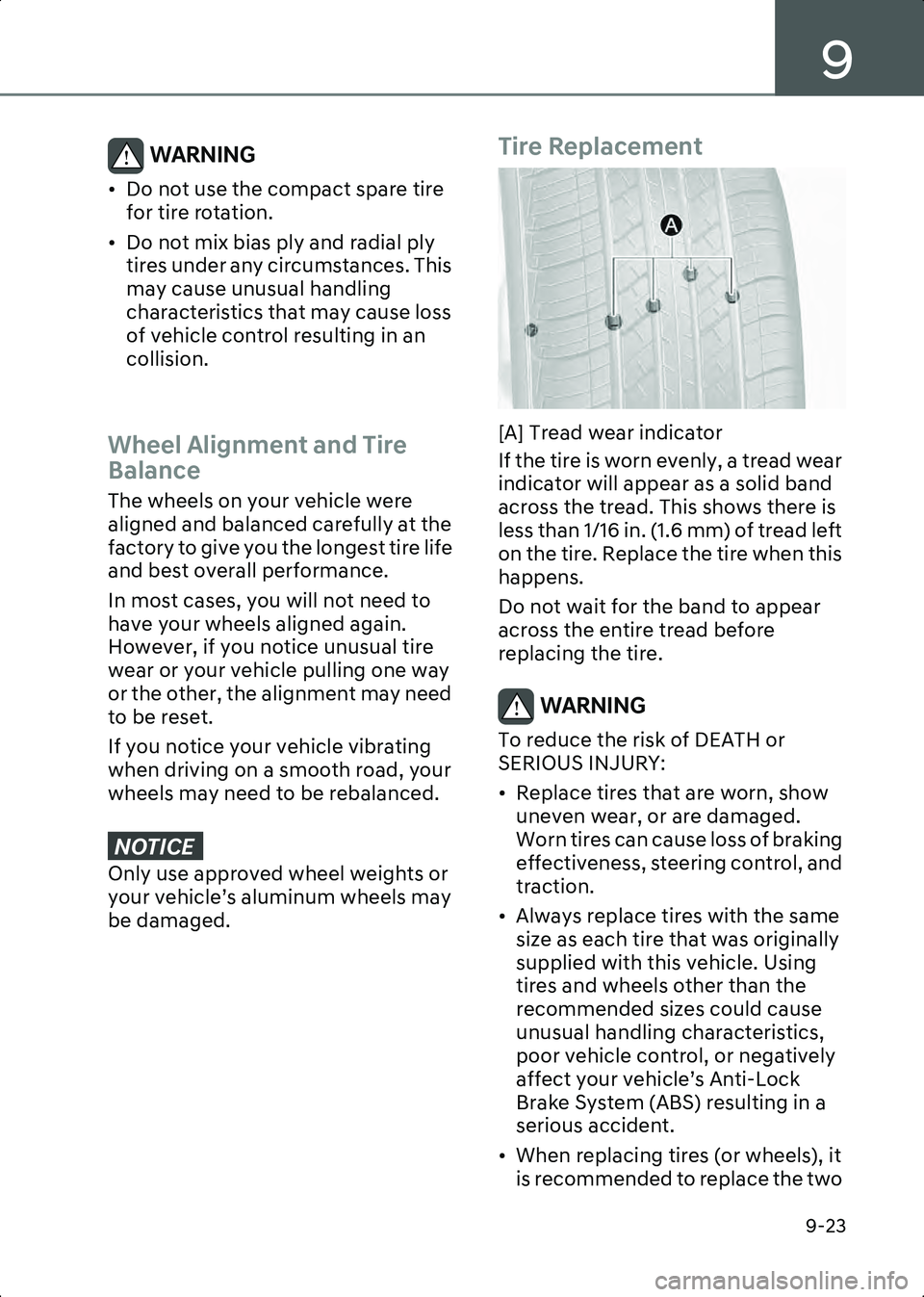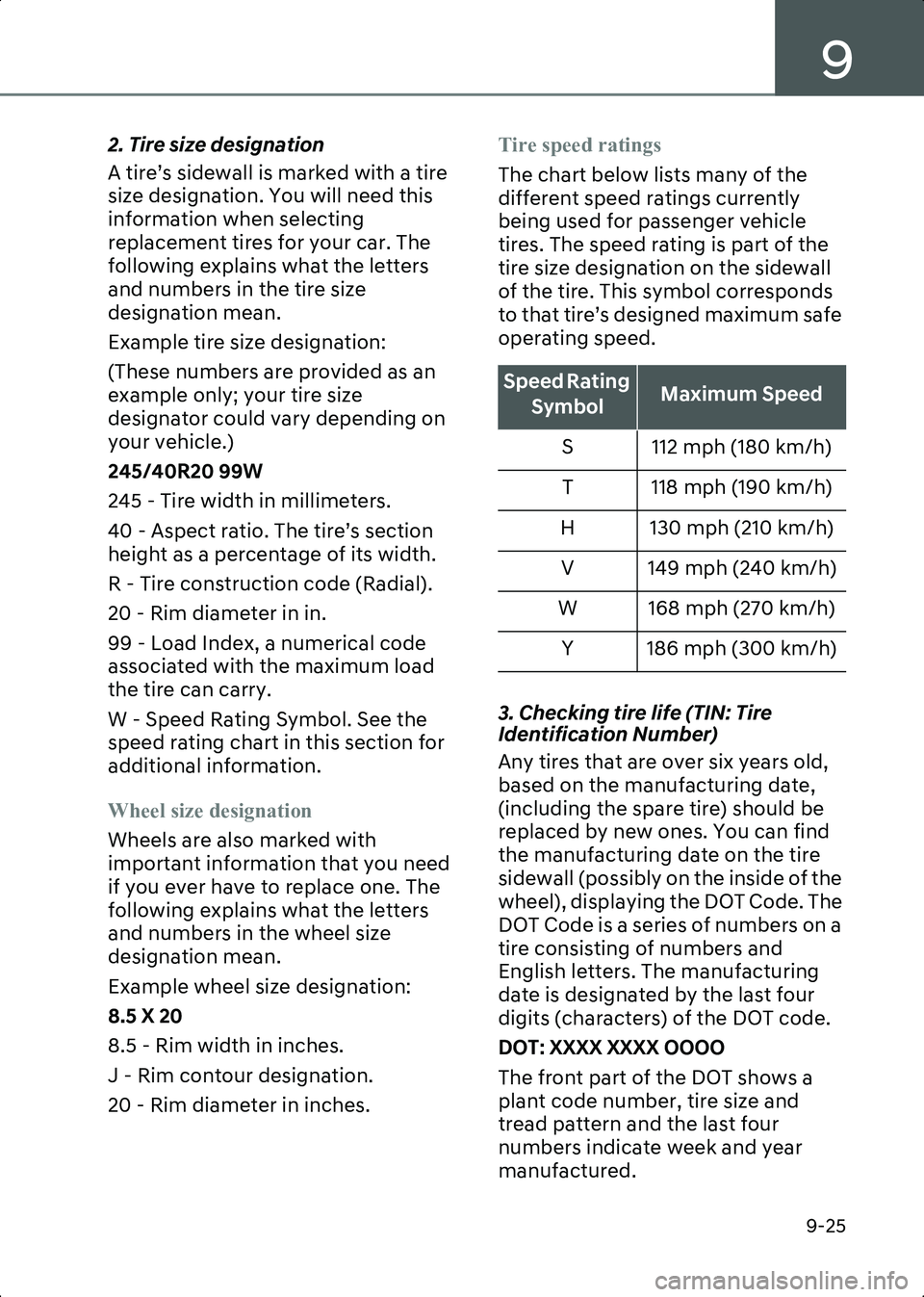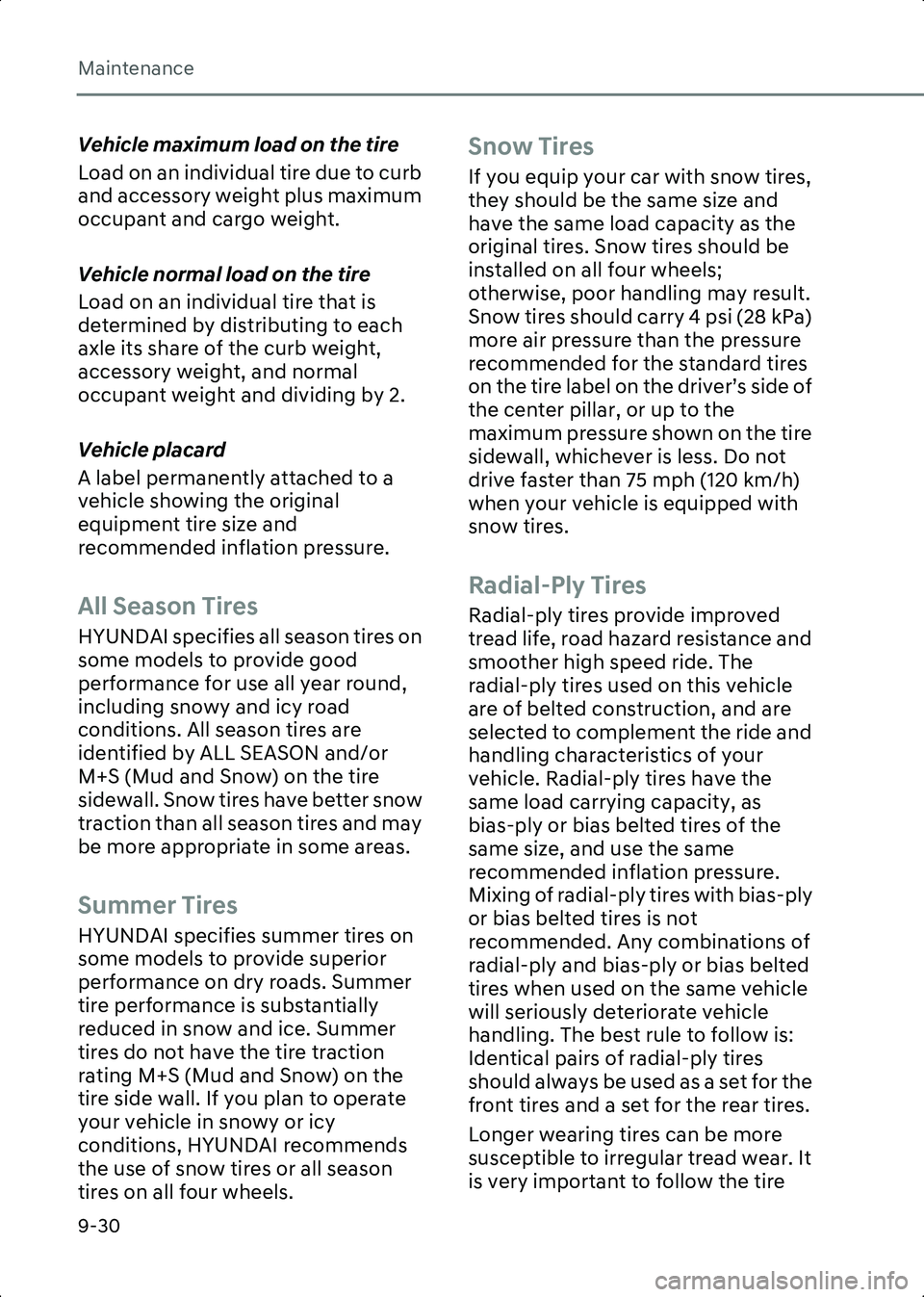Page 539 of 582

9
9-23
WARNING • Do not use the compact spare tire for tire rotation.
• Do not mix bias ply and radial ply tires under any circumstances. This
may cause unusual handling
characteristics that may cause loss
of vehicle control resulting in an
collision.
Wheel Alignment and Tire
Balance
The wheels on your vehicle were
aligned and balanced carefully at the
factory to give you the longest tire life
and best overall performance.
In most cases, you will not need to
have your wheels aligned again.
However, if you notice unusual tire
wear or your vehicle pulling one way
or the other, the alignment may need
to be reset.
If you notice your vehicle vibrating
when driving on a smooth road, your
wheels may need to be rebalanced.
NOTICE���2�Q�O�\���X�V�H���D�S�S�U�R�Y�H�G���Z�K�H�H�O���Z�H�L�J�K�W�V���R�U��
�\�R�X�U���Y�H�K�L�F�O�H�T�V���D�O�X�P�L�Q�X�P���Z�K�H�H�O�V���P�D�\��
�E�H���G�D�P�D�J�H�G��
��
Tire Replacement
B9005201[A] Tread wear indicator
If the tire is worn evenly, a tread wear
indicator will appear as a solid band
across the tread. This shows there is
less than 1/16 in. (1.6 mm) of tread left
on the tire. Replace the tire when this
happens.
Do not wait for the band to appear
across the entire tread before
replacing the tire.
WARNING To reduce the risk of DEATH or
SERIOUS INJURY:
• Replace tires that are worn, show uneven wear, or are damaged.
Worn tires can cause loss of braking
effectiveness, steering control, and
traction.
• Always replace tires with the same size as each tire that was originally
supplied with this vehicle. Using
tires and wheels other than the
recommended sizes could cause
unusual handling characteristics,
poor vehicle control, or negatively
affect your vehicle’s Anti-Lock
Brake System (ABS) resulting in a
serious accident.
• When replacing tires (or wheels), it is recommended to replace the two
Hyundai_CE_en_US.book Page 23
Page 541 of 582

9
9-25
2. Tire size designation
A tire’s sidewall is marked with a tire
size designation. You will need this
information when selecting
replacement tires for your car. The
following explains what the letters
and numbers in the tire size
designation mean.
Example tire size designation:
(These numbers are provided as an
example only; your tire size
designator could vary depending on
your vehicle.)
245/40R20 99W
245 - Tire width in millimeters.
40 - Aspect ratio. The tire’s section
height as a percentage of its width.
R - Tire construction code (Radial).
20 - Rim diameter in in.
99 - Load Index, a numerical code
associated with the maximum load
the tire can carry.
W - Speed Rating Symbol. See the
speed rating chart in this section for
additional information.
Wheel size designation
Wheels are also marked with
important information that you need
if you ever have to replace one. The
following explains what the letters
and numbers in the wheel size
designation mean.
Example wheel size designation:
8.5 X 20
8.5 - Rim width in inches.
J - Rim contour designation.
20 - Rim diameter in inches.Tire speed ratings
The chart below lists many of the
different speed ratings currently
being used for passenger vehicle
tires. The speed rating is part of the
tire size designation on the sidewall
of the tire. This symbol corresponds
to that tire’s designed maximum safe
operating speed.
3. Checking tire life (TIN: Tire
Identification Number)
Any tires that are over six years old,
based on the manufacturing date,
(including the spare tire) should be
replaced by new ones. You can find
the manufacturing date on the tire
sidewall (possibly on the inside of the
wheel), displaying the DOT Code. The
DOT Code is a series of numbers on a
tire consisting of numbers and
English letters. The manufacturing
date is designated by the last four
digits (characters) of the DOT code.
DOT: XXXX XXXX OOOO
The front part of the DOT shows a
plant code number, tire size and
tread pattern and the last four
numbers indicate week and year
manufactured.
Speed Rating
SymbolMaximum Speed
S 112 mph (180 km/h) T 118 mph (190 km/h)
H 130 mph (210 km/h) V 149 mph (240 km/h)
W 168 mph (270 km/h) Y 186 mph (300 km/h)
Hyundai_CE_en_US.book Page 25
Page 546 of 582

Maintenance
9-30
Vehicle maximum load on the tire
Load on an individual tire due to curb
and accessory weight plus maximum
occupant and cargo weight.
Vehicle normal load on the tire
Load on an individual tire that is
determined by distributing to each
axle its share of the curb weight,
accessory weight, and normal
occupant weight and dividing by 2.
Vehicle placard
A label permanently attached to a
vehicle showing the original
equipment tire size and
recommended inflation pressure.
All Season Tires
HYUNDAI specifies all season tires on
some models to provide good
performance for use all year round,
including snowy and icy road
conditions. All season tires are
identified by ALL SEASON and/or
M+S (Mud and Snow) on the tire
sidewall. Snow tires have better snow
traction than all season tires and may
be more appropriate in some areas.
Summer Tires
HYUNDAI specifies summer tires on
some models to provide superior
performance on dry roads. Summer
tire performance is substantially
reduced in snow and ice. Summer
tires do not have the tire traction
rating M+S (Mud and Snow) on the
tire side wall. If you plan to operate
your vehicle in snowy or icy
conditions, HYUNDAI recommends
the use of snow tires or all season
tires on all four wheels.
Snow Tires
If you equip your car with snow tires,
they should be the same size and
have the same load capacity as the
original tires. Snow tires should be
installed on all four wheels;
otherwise, poor handling may result.
Snow tires should carry 4 psi (28 kPa)
more air pressure than the pressure
recommended for the standard tires
on the tire label on the driver’s side of
the center pillar, or up to the
maximum pressure shown on the tire
sidewall, whichever is less. Do not
drive faster than 75 mph (120 km/h)
when your vehicle is equipped with
snow tires.
Radial-Ply Tires
Radial-ply tires provide improved
tread life, road hazard resistance and
smoother high speed ride. The
radial-ply tires used on this vehicle
are of belted construction, and are
selected to complement the ride and
handling characteristics of your
vehicle. Radial-ply tires have the
same load carrying capacity, as
bias-ply or bias belted tires of the
same size, and use the same
recommended inflation pressure.
Mixing of radial-ply tires with bias-ply
or bias belted tires is not
recommended. Any combinations of
radial-ply and bias-ply or bias belted
tires when used on the same vehicle
will seriously deteriorate vehicle
handling. The best rule to follow is:
Identical pairs of radial-ply tires
should always be used as a set for the
front tires and a set for the rear tires.
Longer wearing tires can be more
susceptible to irregular tread wear. It
is very important to follow the tire
Hyundai_CE_en_US.book Page 30